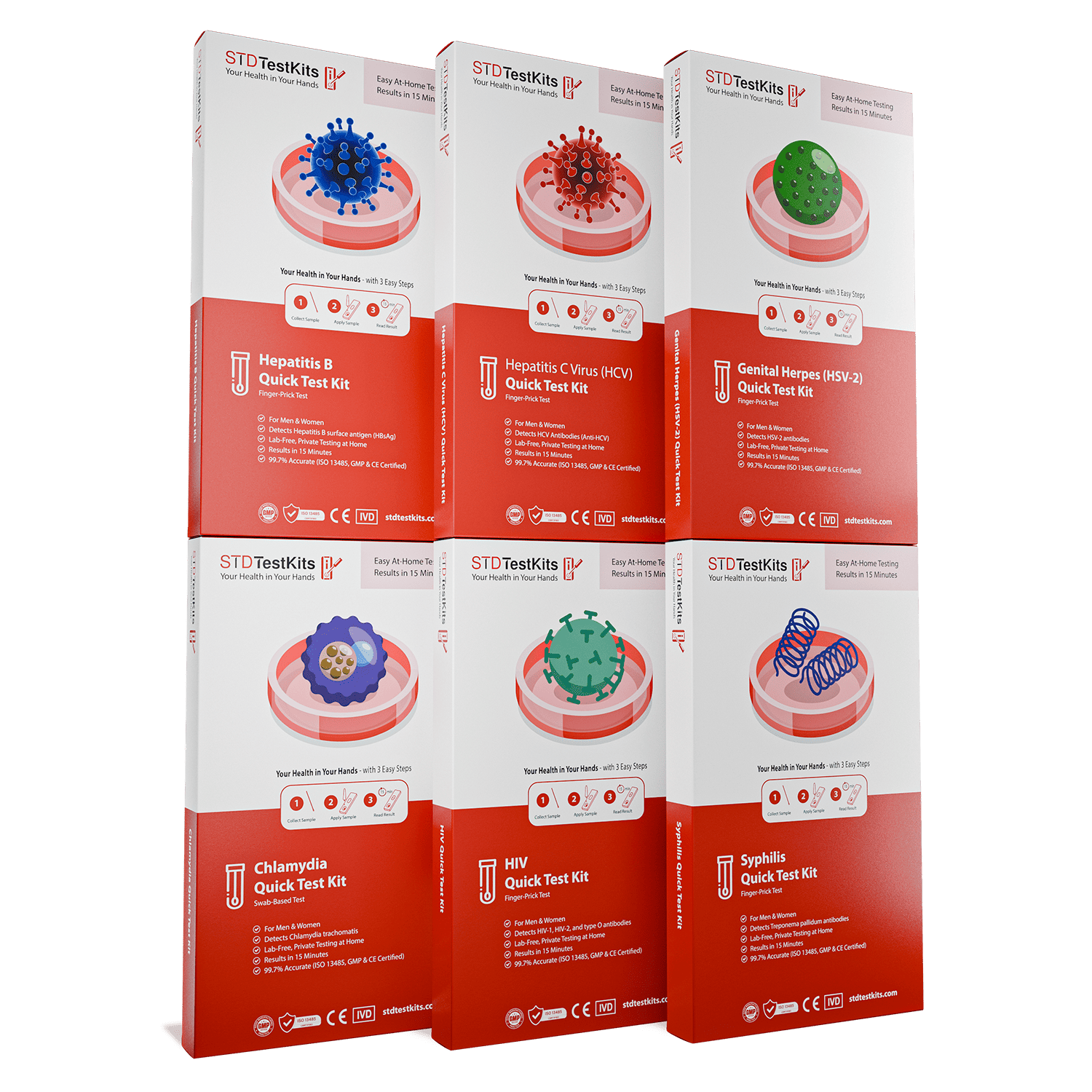How Accurate Are Syphilis Rapid Tests in 2025?
Quick Answer: A newly released global report predicts nearly $31 billion in STD diagnostic growth by 2033, fueled largely by at-home and point-of-care testing. This trend means faster, more private access to results without clinic delays.
According to the Research and Markets report of November 2025, the new tech, increasing infection rates, and global efforts for better access have hiked growth in the STD diagnostics sector at almost 7% annually. But here's the thing: this growth is not all happening in hospital labs. It's happening in backpacks and nightstands and medicine cabinets, where over-the-counter STD kits are being used in quiet, quick, and user-controlled ways.
This article unpacks what the market data really means: why STDs are spreading, how testing is evolving, and why self-testing is no longer fringe. We’ll walk through the science behind these tests, their strengths and gaps, and exactly how to use them when privacy or convenience matter most. Whether you're testing for peace of mind or navigating a recent hookup, here’s how the future of diagnostics puts power, and answers, right into your hands.

People are also reading: I Have Gonorrhea, Do I Need a Shot or a Pill?
Who This Guide Is For (And Why It Matters)
Maybe your last partner wasn’t as transparent as you hoped. Maybe you’re between clinics, uninsured, or just not ready to talk to a stranger about what’s going on down there. Whatever your reason, this guide is for anyone who's looking for clarity, without the cost, the judgment, or the wait.
We’re talking to college students trying to avoid a walk of shame to student health, to long-distance partners juggling time zones, to truckers and freelancers and exhausted parents. Testing at home isn’t a last resort, it’s a first step that’s private, powerful, and now increasingly accurate thanks to innovations the global report spotlights, like NAAT kits and rapid antigen tests.
What Actually Counts as an STD Test?
Let’s strip this down to basics. STD tests are typically one of three things: molecular (like NAAT or PCR), antigen/antibody detection, or visual rapid assays. The most accurate ones, NAATs, search for the actual genetic material of the infection. That’s why they’re the gold standard for infections like chlamydia, gonorrhea, and trichomoniasis.
At-home tests now include both lab-grade mail-ins (where you send your sample to a lab) and rapid kits you use and read at home. The latter often resemble pregnancy tests or COVID tests. They’re getting faster, better, and more accessible every year. According to the CDC, NAAT testing remains the most sensitive and specific method for many STIs, and now that tech is increasingly available over-the-counter.
You can explore our full range of discreet test kits at STD Test Kits. Want to cover all your bases in one go?
Window Periods: What to Know for Each STD
It’s not just about what you test for, it’s about when. The “window period” is the time between exposure and when a test can reliably detect infection. Testing too early can lead to false negatives, which can give a dangerous sense of relief. Testing too late can mean more spread, more symptoms, and more damage.
Figure 1. Window periods vary by infection and test type. Testing too early can miss infections, especially in asymptomatic people.
Rapid Test vs Lab Test: Pros, Cons, and Tradeoffs
You’re in a Walgreens parking lot with a rapid test in your lap. Or maybe you’ve just sealed a swab into a prepaid mailer, fingers crossed it gets to the lab fast. Testing isn’t just clinical anymore, it’s deeply personal. And with the global diagnostics market surging, more of that power is shifting into users’ hands.
Let’s compare how today’s options stack up:
Figure 2. Comparison of current testing methods by privacy, speed, and accuracy.
According to the CDC’s STI treatment guidelines, point-of-care tests now play a crucial role in reducing transmission by offering immediate treatment pathways. For many, rapid tests mean one thing: no more waiting, no more judgment, just answers.
When to Test After Exposure
If it's been a day or two since something risky happened, you might want to test now. But here's the thing: that sense of urgency could make you think you don't have it. The fear is real, but the body needs time to show signs of infection.
Take a breath if it hasn't been five days yet. Testing this early usually won't find most STDs. Are there any exceptions? If you have painful symptoms or were sexually assaulted, get help right away. No matter when they are, clinics can still offer basic screening and treatment.
Some tests, like NAATs, may be able to find early infections, especially chlamydia or gonorrhea, between 7 and 13 days. But you should be careful when you look at the results. This is a great time to do a first test and plan to do it again.
This is the best time for accuracy after 14 days. When it comes to syphilis, HIV, and trichomoniasis, the body usually makes enough markers for reliable detection. If symptoms continue or the risk remains, retesting at a later time may still be necessary.
Case snapshot: Dre, 27, took a quick test for chlamydia five days after a hookup. It was not true. He still felt like something was wrong, though, so he tested again on day 15 with a mail-in NAAT kit. This time? Yes. The first test gave false hope, but the second test found what was important. That's how strong retesting windows are.
Are you wondering if it's too early or too late to test? This combo test kit can check for several infections and can be retaken privately at a time that works best for you.
Do You Need to Retest? Here’s How to Know
Let’s be real: most people don’t want to test twice. But sometimes, once just isn’t enough, especially if symptoms change, new exposure occurs, or the first test was taken too early.
After treatment: You might still test positive for a short time even if the infection is gone. For chlamydia or gonorrhea, retesting at 3 months is recommended, both to catch reinfection and verify clearance. Avoid testing within 3 weeks of antibiotics unless advised.
Without treatment: If you’re asymptomatic but still concerned, retesting around 30–45 days post-exposure can increase detection accuracy. This is especially true for slower-appearing infections like syphilis.
Micro-scene: Lara, 34, used a rapid herpes test after a weekend fling. She didn’t have symptoms, just nerves. Negative. A month later, a tingle on her lip sent her spiraling. Her follow-up test caught an early HSV-1 infection. If she’d trusted the first alone, she never would’ve known to protect future partners.
Stigma Still Blocks Testing, Even When It’s Free
The market may be booming, but stigma hasn’t vanished. According to the 2025 market report, social shame remains one of the biggest barriers to testing, even when the test is free and available at home. This fear disproportionately affects younger people, LGBTQ+ communities, and those living in conservative or rural areas.
Ravi, 21, kept his rapid HIV test hidden in his glove compartment for a week.
“I wanted to know. But I couldn’t even open the box,” he said. “What if someone saw it? What if it said positive?”
Ravi finally took the test in a rest stop bathroom after a weekend trip, and got the negative result he needed to sleep again.
This is what most STD reports don’t show: it’s not just about access. It’s about emotional access. Until we normalize testing as a form of care, not confession, millions will continue to wait too long, or not test at all. The good news? Self-testing is one of the strongest antidotes to stigma. When it’s just you, a test, and a few minutes of courage, the power shifts.
Global Access Gaps: Where the Market Still Fails
While the market climbs toward $30 billion, not everyone is on the ride. The 2025–2033 report bluntly states what public health experts already know: low- and middle-income countries are being left behind. Sophisticated diagnostics like PCR and NAAT are rarely available in rural clinics, and often unaffordable when they are.
Ironically, the regions with the highest STD burdens, sub-Saharan Africa, parts of Southeast Asia, rural Latin America, have the fewest options for accurate diagnosis. Some areas still rely on symptom-based diagnosis alone, which often misses asymptomatic cases entirely.
Even rapid tests aren’t a universal fix. Many over-the-counter options are still too expensive or not locally approved. That’s why expanded NGO partnerships, government subsidization, and test donations are essential to bridging the gap.
In 2024, Canada launched the STBBI Action Plan with $2.45 million in funding aimed at improved screening and outreach. Other nations are following suit, but the need is urgent. Every delay in diagnosis creates more chains of transmission, and more irreversible consequences.

People are also reading: Ireland’s STI Testing Crisis Isn’t Just Ireland’s Problem, It’s Worldwide
Technology Is Catching Up With Real Life
The good news? Testing technology is accelerating at a rate we haven’t seen before. The Research and Markets report emphasizes the rise of molecular diagnostics, including home-based PCR and real-time NAAT kits. These once lab-exclusive methods are now showing up on pharmacy shelves and ecommerce sites.
In April 2023, Jiangsu Bioperfectus Technologies released its CE-marked Herpes Simplex Virus Type I/II Real-Time PCR Kit. That might sound like jargon, but it means you can now detect both types of HSV with lab-level accuracy, faster and earlier than ever, without stepping into a clinic.
Even AI is entering the scene. Diagnostic algorithms are being trained to interpret test results, spot false positives, and recommend next steps, without human bias or delay. And while many of these features remain in clinical settings for now, the next wave is clear: smart diagnostics for smart phones, tied to smart decisions.
It’s no longer just about catching STDs. It’s about catching them early, affordably, and without fear. And the tech is finally catching up to what real people need: answers they can trust, actions they can take, and privacy they can count on.
Privacy, Shipping, and Discreet Support
At-home testing only works if it feels safe. That’s why companies are investing heavily in discreet packaging, unmarked billing, and flexible support options. The box doesn’t say “STD” in big red letters. The transaction doesn’t scream what you’re dealing with. And the results come straight to your phone or inbox, no judgment, no gossip, just data.
Most major kits ship within 24–48 hours. And for folks in remote areas, that speed matters. If you’re in a small town, hundreds of miles from the nearest clinic, getting a chlamydia test kit at your door can be life-changing.
Tonya, 39, lives off-grid in Arizona and used to drive five hours roundtrip for basic sexual health care.
“Now I can test at home,” she says. “It’s quiet. It’s mine. I don’t need to explain anything to anyone.”
That’s the magic self-testing offers, not just convenience, but sovereignty.
What If You Test Positive?
This is where fear can hijack logic. You see a positive result, and suddenly your brain is racing: Who gave it to me? Who have I hurt? Am I broken?
Stop. Breathe. The most common STDs, chlamydia, gonorrhea, trichomoniasis, are all treatable with routine antibiotics. Even chronic infections like herpes or HIV can be managed safely, allowing for full lives, intimacy, and love.
The first step after a positive result is confirmatory testing, especially if the test was done at home. This helps rule out user error or low-sensitivity kit misreads. Next? Start treatment. Most clinics and telehealth services can prescribe remotely if needed.
Ty, 31, got his syphilis diagnosis from a rapid blood test.
“I panicked,” he said. “But the clinic explained everything. I got treated the same day. I told my partner that night.”
Today, Ty carries his experience not as shame, but as proof he’s not afraid to take care of his health.
You’re not dirty. You’re not broken. You’re just informed. And now, you can act.
FAQs
1. Are at-home STD tests actually legit?
Yep, especially if you're using a test with NAAT (nucleic acid amplification) tech or one that’s lab-analyzed. Rapid tests are great for a quick answer, but if your result is fuzzy or you’re in an early window period, plan to test again. The key? Use a reputable brand, follow instructions, and trust your gut if something feels off.
2. I don’t have any symptoms. Should I still test?
1000% yes. Most STDs don’t send up red flags, especially chlamydia and trichomoniasis. People go months or even years without a clue anything’s wrong. Think of testing like brushing your teeth. It’s not because something hurts. It’s because you care about your health before things get messy.
3. What does it mean if the test line is super faint?
Faint lines still count. Whether it's pregnancy, COVID, or herpes, a line’s a line. That said, if your test doesn’t match the example in the instructions, snap a pic and recheck in a day or two with a new kit or lab test. Also: don’t squint yourself into a panic. Some kits are just... finicky.
4. Is it risky to test while on antibiotics?
Kinda. Antibiotics can mess with the accuracy by knocking out bacteria before the test catches it. If you’re already on meds, wait until they’re done unless a doctor says otherwise. Testing mid-treatment can give you weird results, and a whole lot of “what does this even mean?” vibes.
5. Can I use one kit to test for everything?
Not quite, but some come close. Combo kits usually cover chlamydia, gonorrhea, syphilis, and HIV, sometimes more. But for things like herpes or HPV, you’ll need a dedicated test. The takeaway: read what’s included before assuming you’ve got it all covered.
6. What if I test too early after a hookup?
That’s the classic “too soon to know” problem. If you test within 5 days of exposure, you might get a false negative, even if you’re infected. Your best bet? Wait for the window period (usually 1–3 weeks depending on the STD) or test now and plan to test again later. Early testing is fine for peace of mind, but don’t let a single negative result close the book.
7. How private is all of this, really?
Extremely. Discreet packaging, no “STD” labels, private results, nobody has to know unless you want them to. Plus, when you order from legit sites like STD Test Kits, your info is protected and your order just looks like any other health product. So yeah, your business stays your business.
8. Do I need to tell anyone if I test positive?
Morally? If you have partners, yes. Medically? Some infections are reportable (like HIV and syphilis), but that’s more about public health than personal exposure. The key is to tell recent partners in a way that’s clear, kind, and direct. Scripts help. So does wine. Or tea. We’ve got resources if you need them.
9. How often should I get tested?
Think of it like dental cleanings, except way more fun. If you’re in a monogamous relationship, once a year might be fine. If you’ve got multiple partners, just hooked up with someone new, or had unprotected sex, test every 3–6 months. And after any “oops” moment? Yeah, it’s time.
10. Why is this still so awkward in 2025?
Because shame is stubborn. But that’s changing, because of people like you who choose to test, talk about it, and normalize the hell out of it. Testing doesn’t mean you did something wrong. It means you’re smart enough to protect your future self (and your partners) today.
You Deserve Answers, Not Assumptions
Whether you’re reacting to a scare, checking in during a new relationship, or simply reclaiming control of your body, testing is power. It’s how you protect yourself and your partners. It’s how you break the chain before it starts.
Don’t let stigma, cost, or confusion stand in your way. Testing is getting faster, easier, and more discreet by the day, because you deserve peace of mind without the runaround.
Need clarity? This combo test kit delivers fast answers without judgment, so you can move forward, informed and confident.
How We Sourced This Article: We combined current guidance from leading medical organizations with peer-reviewed research and lived-experience reporting to make this guide practical, compassionate, and accurate. In total, around fifteen references informed the writing; below, we’ve highlighted some of the most relevant and reader-friendly sources.
Sources
1. CDC – STI Treatment Guidelines
3. Getting Tested for STIs | CDC
4. Advances in Sexually Transmitted Infection Testing | STD Journal
5. Direct-to-Consumer Testing: A Game-Changer for STI Control and Public Health? | MDPI
About the Author
Dr. F. David, MD is a board-certified physician in Infectious Diseases, including the prevention, diagnosis, and management of STIs, as well as an expert in sex positivity, who skillfully marries his scientific expertise with his no-nonsense, sex-positive philosophy for bringing this information to more people, even those in off-grid environments.
.
Reviewed by: Maria Estevez, MPH | Last medically reviewed: November 2025
This article is for informational purposes and does not replace medical advice.







